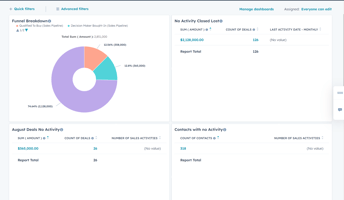As your business grows, keeping a clear picture of your sales pipeline can be a daunting task....
Uncovering ABM Opportunities with HubSpot: A Deep Dive
Small businesses need to be creative in order to maximize the ROI from their data. They do not have an endless budget to dump into demand gen activities. ABM is one tool that anyone can wield but the challenge lies in identifying these prime opportunities within your existing database. Leveraging HubSpot’s powerful CRM features, you can efficiently sift through your contacts and companies to uncover the best ABM prospects.
In this post, we’ll explore how to use HubSpot to find ABM opportunities, including key areas of evaluation and the data points that provide actionable insights.
Why Use HubSpot for ABM Opportunity Identification?
HubSpot’s CRM offers a wealth of data on your contacts and companies, from demographic details to behavioral insights. By harnessing this information, you can segment your database, score leads, and pinpoint accounts that align with your ideal customer profile (ICP).
Step 1: Define Your Ideal Customer Profile (ICP)
Before diving into your HubSpot database, establish a clear ICP. Your ICP should reflect the characteristics of accounts that bring the most value to your business. Key attributes may include:
- Industry: Focus on sectors where your solutions have proven successful.
- Company Size: Determine whether you are targeting small businesses, mid-market companies, or enterprise-level accounts.
- Revenue Range: Consider which revenue brackets align with your most profitable clients.
- Geographic Location: Identify any regional preferences or limitations based on your business focus.
With a well-defined ICP, you’ll have a roadmap for searching your database effectively.
Step 2: Utilize HubSpot’s Contact and Company Filters
HubSpot’s filtering capabilities are a powerful tool for narrowing down your list of potential ABM targets. Here’s how you can use them:
-
Contact and Company Properties: Filter contacts or companies based on specific properties like industry, annual revenue, and employee count. These properties help you identify accounts that match your ICP.
-
Lifecycle Stage: Use the lifecycle stage property to find leads that have moved beyond the awareness phase and are in the consideration or decision stages. These accounts are more likely to benefit from a targeted ABM approach.
-
Engagement Metrics: Look at metrics such as email opens, website visits, and form submissions. High engagement is a strong indicator of interest and should be factored into your ABM targeting.
Step 3: Analyze Behavioral Data for ABM Indicators
Behavioral data provides deep insights into how contacts and companies interact with your content. In HubSpot, focus on the following data points:
- Website Activity: Use the HubSpot tracking code to monitor visits to high-intent pages, such as product pages, pricing, or case studies. Frequent visits to these pages indicate strong buying interest.
- Email Interactions: Track email engagement, including open rates and click-through rates. Contacts that engage with specific ABM-focused content, such as whitepapers or eBooks, are prime candidates for targeted outreach.
- Event Participation: Analyze webinar attendance or event registrations from your HubSpot forms. Attendees often represent decision-makers or key influencers within their organizations.
Step 4: Score and Prioritize Your ABM Leads
HubSpot’s lead scoring feature can help you rank potential ABM targets based on fit and interest. Customize your scoring model to prioritize contacts and companies that meet your ICP criteria and demonstrate strong engagement signals.
- Demographic Scoring: Assign points based on company size, industry, and location. This helps ensure the contacts align with your strategic focus.
- Behavioral Scoring: Increase scores for actions like multiple website visits, form submissions, or high engagement with targeted content.
- Deal Stage: Consider adjusting scores based on the deal stage. Contacts that are already associated with open deals may be prime ABM candidates for marketing and sales alignment.
Step 5: Use HubSpot Lists and Workflows for Segmentation
Once you’ve identified potential ABM opportunities, use HubSpot’s lists and workflows to segment and nurture these accounts effectively:
- Static and Active Lists: Create static lists for one-time ABM campaigns or active lists that automatically update based on your criteria (e.g., companies with over 500 employees that have visited your pricing page in the last 30 days).
- Workflows: Automate personalized touchpoints using workflows. For instance, trigger a sequence of tailored emails or assign a task to a sales rep when a high-value contact engages with a key piece of content.
Step 6: Align Marketing and Sales for ABM Success
For ABM to be effective, sales and marketing must work hand-in-hand. HubSpot’s integrated CRM makes it easy to share insights across teams:
- Shared Deal Data: Use the deal pipeline to provide sales with a clear view of high-priority accounts and their engagement history.
- Notes and Activities: Keep detailed notes on ABM accounts and log activities such as phone calls and meetings directly in HubSpot. This helps ensure that all team members are on the same page.
- Custom Reports: Generate reports that highlight key ABM metrics, such as account engagement, open deals, and conversion rates. This data helps refine your targeting strategy and measure the impact of your ABM efforts.
Conclusion: Unlocking ABM Opportunities with HubSpot
HubSpot offers a robust suite of tools to help you find and nurture ABM opportunities within your existing database. By focusing on the right data points and leveraging features like filters, lead scoring, and automated workflows, you can streamline your targeting efforts and drive meaningful engagement with high-value accounts.
To learn more about setting up an effective ABM strategy using HubSpot, visit our HubSpot services page.


